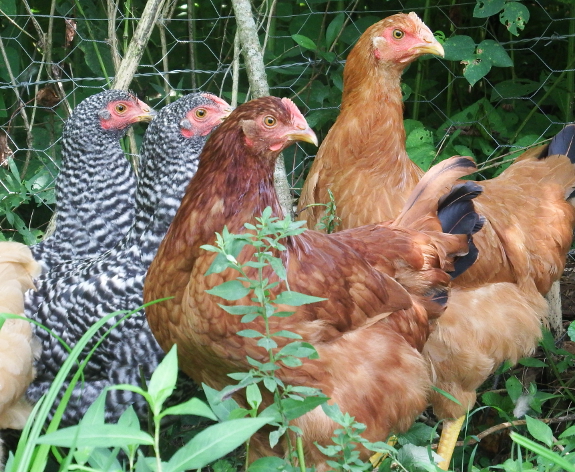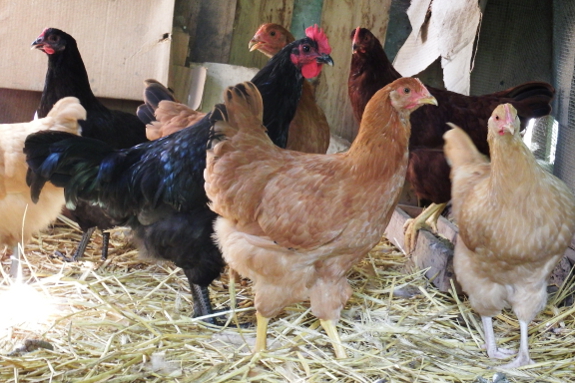
Heirloom chicken trials

With three more cockerels in the freezer, I'm ready to pass judgment on this year's round of experimental chicken breeds. I didn't raise the five varieties separately, so I can't tell you who cost the least to feed, but I do have data on foraging ability, rooster weight at roughly fifteen weeks, and survivability. I'll start with the last.
We had quite a few predator losses this year, mostly due to human error (we forgot to shut in the chicks
a few nights) but also partly because our guard dog is getting on in
years and sleeps more soundly than she used to. It could be entirely
random which chicks got picked off, but I wanted to mention that the
australorps came through unscathed, the orpingtons only lost one bird,
and the three other varieties lost two birds apiece. This is interesting
because I'd read that dominiques are very good free-range birds because
they're less likely to get picked off --- that wasn't the case in our
very small sample.

Moving on to meat
qualities of the birds, I don't have any data on dominiques or New
Hampshire reds. It turns out we did end up with one dominique cockerel,
but his comb was so small when we went to snatch birds off the roost by
flashlight that I thought he was a girl! And all of our surviving New
Hampshire reds turned out to be girls as well. So you'll have to wait
for an update on meat qualities of these two breeds at a later date.
My all-around favorite
(without tasting any of the meat) is definitely the Rhode Island red
(the dark brown bird in the photo above). Australorps grew a little
bigger (averaging 2 pounds 13.9 ounces dressed for the australorps
versus 2 pounds 11.9 ounces dressed for the Rhode Island red), but the
Rhode Island red had the brightest fat. This is a key indicator if
you're looking for high-quality pastured meat since yellow fat comes
from birds that forage the most, meaning you're getting more omega 3s
and the birds are probably eating less feed.
In contrast, our orpington cockerels were big losers, having quite pale fat that almost looked like the fat on a cornish cross.
The orpingtons were also the lightest birds at fifteen weeks, clocking
in at 2 pounds 6.2 ounces. Although they'll likely catch up to the other
breeds later, this slow growth probably also means they eat more feed
for every pound of meat that ends up on the table (although I can't be
positive of that fact). As a final nail in the breed's coffin, the
orpingtons are the only birds in this flock who have been causing
trouble, refusing to abide by my pasture rotation and returning time
after time to the first pasture we started them out in. So while Kayla
assures me that orpingtons are good pet chickens, I'm afraid I have to
take them off my list of prime thrifty chicken breeds.
Want more in-depth information? Browse through our books.
Or explore more posts by date or by subject.
About us: Anna Hess and Mark Hamilton spent over a decade living self-sufficiently in the mountains of Virginia before moving north to start over from scratch in the foothills of Ohio. They've experimented with permaculture, no-till gardening, trailersteading, home-based microbusinesses and much more, writing about their adventures in both blogs and books.
Want to be notified when new comments are posted on this page? Click on the RSS button after you add a comment to subscribe to the comment feed, or simply check the box beside "email replies to me" while writing your comment.

We're finished with Buff Orpingtons as well. We've had ours for going on four years and they are indeed notorious for not staying where you want them. Our Buff rooster was a real rabble-rouser and we don't miss him! They're only plus is that they were good at going broody and mothering. The last of the Buff hens are slated for canned chicken come cooler weather.
This year we've got Black Australorps and hope they are "it." They have grown quickly and I've never had a rooster try to crow at such a young age! I've had mixed reports on broodiness, which I need for sustainable chickens, so we'll see!
Very timely post since yesterday was first culling for me. I managed six cockrell and two pullets before my back demanded that I call it a day. After reading your post I decided to do a 5 AM sorting rather than chase them in the tractor; much easier thanks! The birds are huge but still smaller than hormone filled store birds. They eat a lot though averaging 1/2 pound per week. They forage fairly well with nice yellow fat.
I kept two cockerells and six pullets for breeding. I'm interested in seeing how they lay althought they are reported to be good layers with large eggs. I currently have 12 Dominique and six Sexlet hens that lay very well until it got over 90F. The Sexlets give good extra large eggs plus a dozed jumbo-plus eggs that I sell for $4 vs $3/dozen. I won't be retiring to Jamaica but I get enough to pay for aĺl my feed meaning free eggs and now meat. Hopefully the cockerells will 'man up' and quit being pushed around by my mature hens